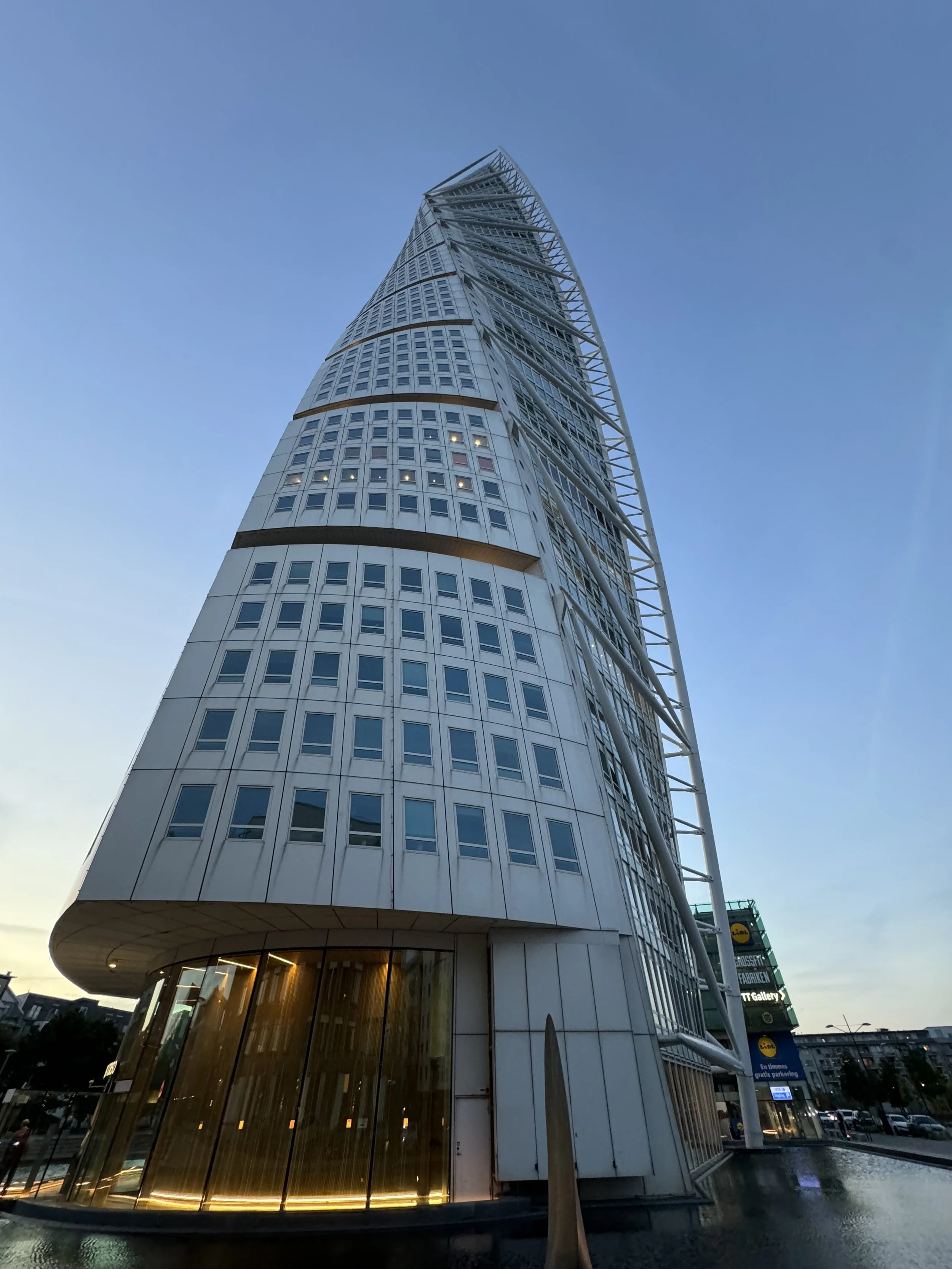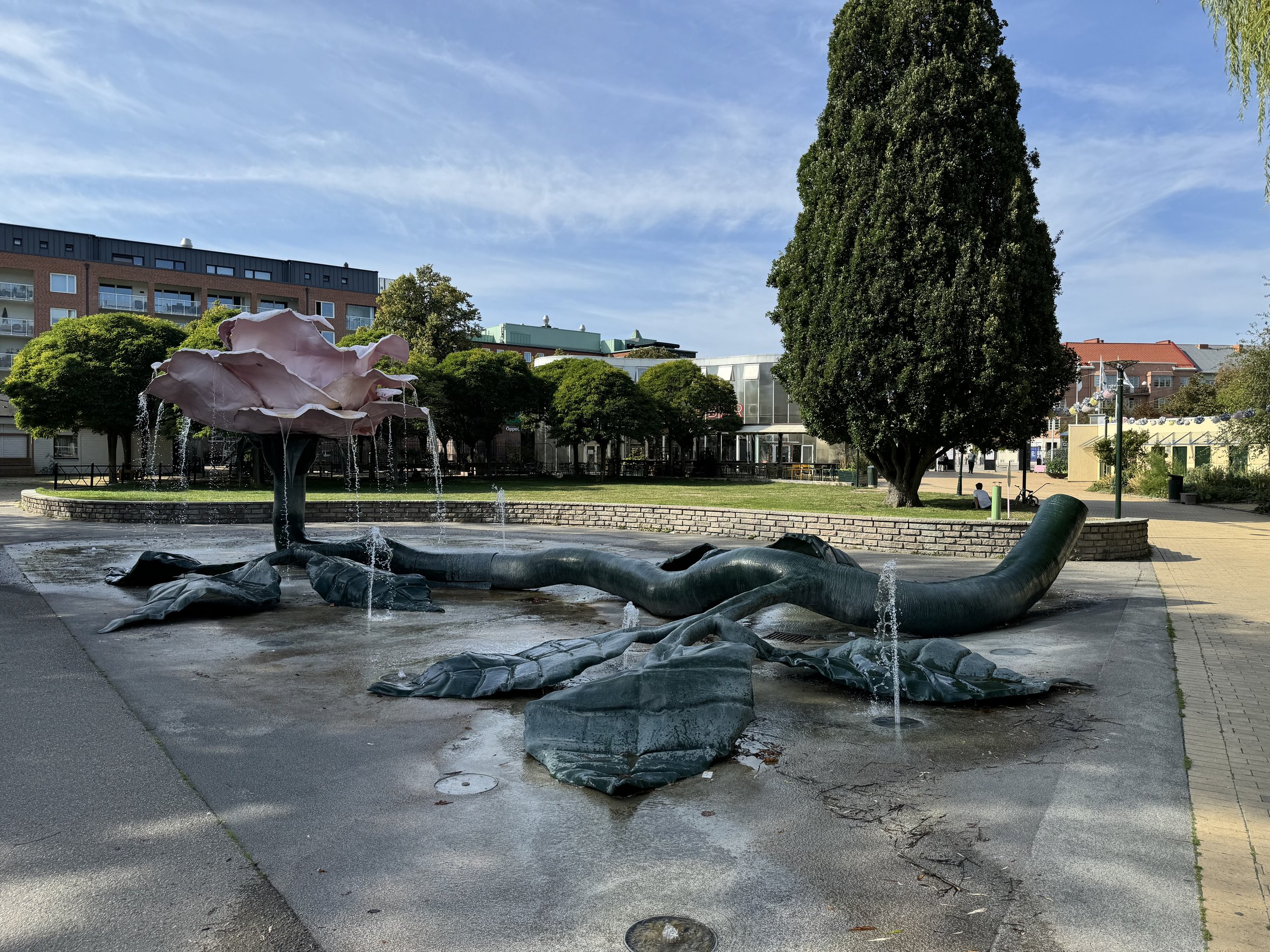The Turning Torso
This wacky residential building twists up into the sky, turning slightly every 6 floors. The building makes a complete 90 degree turn from bottom to top!
Today we added another city to our list of places to visit on-the-fly. That city is Lund, Sweden. We had thought about overnighting in Lund when we were planning this trip, but we decided that it might be a bit much with our agenda. Well, things have gone so smoothly with transportation and our touring objectives, that we felt like we could make a day trip from Malmö to Lund!
We woke up later and grabbed breakfast at the hotel. We walked to Malmö Central station and hopped on a train for a short 10 minute ride to our destination. Lund is known as a university town, and it is one of the oldest cities in Sweden. There is no definitive date for the city’s founding, but it is believed that the first foundations for the city were laid in the 10th century.
Lund is home to the Lund Cathedral, formerly a catholic cathedral and today a Lutheran church. The church houses a number of amazing things. The MOST amazing of these things is an astronomical clock. The clock has a top and a bottom portion, and each section gives you different information. The top section shows the position of the sun on the horizon (in reference to the position of the cathedral) and in the current zodiac as well as the time (provided in 2, repeating 12-hour counts). One hand on this clock has an orb that represents the moon on the end of an arm. The moon actually rotates on the arm independently as the arm moves, revealing the current phase of the moon. There are indicators on the clock face for different ellipticals of the sun and moon, which allow you to see the equinoxes.
The bottom of the clock has a dial that rotates one notch every 24 hours. It is significantly less impressive in my opinion, but it reveals with accuracy the correct date on the calendar. The years listed on the clock extend to the 2130s! The calendar date is indicated by a wood carving of a man pointing a stick at the dial. There are a number of letters indexed to the date, which provide the keys to reading the information on the inner dials (non-moveable). These are the various naming days and feast days for saints and such.
The clock also has an audio-visual component! At noon each day (and presumably for other hours) the clock will animate to announce the time. Two knights at the top of the clock, representing good and evil, bash their swords together as many times as the hour being announced. Then, a parade of bishops circles in front of the figure of the christian virgin Mary. They carry gifts to their god,Yahweh, and they are tailed by servants. Two trumpeters play a medieval tune as the parade occurs. It’s like an ancient cuckoo clock!
We also toured the crypt of the cathedral, where we found many ancient graves and Finn the Giant. The story of Finn the giant goes roughly as such: There was a monk in Lund, who preached to the people of Lund up on a hill. Finn and his wife and child lived under that hill, unbeknownst to the monk and the people. Finn confronted the monk and demanded to know why they were all disturbing his family with all this racket. The monk told Finn that they gather there because Lund has no church. Finn made the monk an offer. He told the monk that he will build the church if the monk can pluck the sun and moon from the sky for his child. The monk stated this was not possible, so Finn the Giant offered that the monk should pluck his eyes out upon completion of the church instead, UNLESS the monk could guess the name of the giant. The monk accepted. Finn brought stones to the site of the church and built it up, block by block. The monk guessed over the construction many many times what the giant’s name could be, but he could not come up with the correct name. Finally, one day the monk heard the giant’s wife singing to her child. The song mentioned that the child’s father was, “Finn.” So the monk ran to the cathedral just as the giant was about to lay the final stone and announced, “Finn, Finn, lay the final stone!” The giant threw the final stone down and became so angry that he descended to the crypt to tear the church down. He latched onto one of the pillars and turned into stone before he could tear it down.
Finn is still down there today in the crypt, trying to bring the church down. his wife and child are also immortalized on another column in the crypt as well. It is thought that these figures could have originally been other biblical story figures like Samson and Delilah; however, no one is certain, and I like the Finn story much better. The cathedral square contains stone-block like benches that you can move wherever you like, and each one is inscribed with that quote from the story, “Finn, Finn, lay the final stone!”
After a ton of picture taking in the pretty cathedral, we toured the university campus of Lund, which included some pretty flowers, buildings, and a hill with actual Viking rune stones! We grabbed a snack at a local coffee shop and then caught a train back to Malmö, glad for the excursion.
Back in Malmö, it was time to eat a quick lunch, and then we jumped on scooters to the world’s oldest “People’s Park,” Folkets Park. What is a People’s Park? I’m not exactly sure, but it seems to have something to do with a popular community movement being involved in its establishment. Folkets park has a number of really cool theater facilities for music and drama performances (stages), grassy fields for picnics, fountains, benches, vendors, and a tremendous playground for kids to run around and play in. It’s a sort of all-around community park that is the size of multiple city blocks. There is no price for admission! The park is open to all. Jessi and I toured the park and took a bench for a while. Then, we toured the park some more and reclined on a comfy large wooden lounger together for a while. The whole park is decked out in pink and white for all of the blooming flowers around. People were out recreating, taking their kids to the splash park, and eating ice cream and popcorn (ok, that last one was us).
From there, we scootered over to Pildammsparken near the opera house and strolled along the scenic pond, where Jessi identified a new life bird (Jessi is a birder) by sight based on her experience with he game Wingspan. We checked out the old water tower, which looks like a castle turret, and then we walked over to the opera house for a look-see. We were pretty exhausted, so we made our way back to the hotel for a quick rest.
After that we grabbed some dinner at a restaurant on the Øresund waterfront. We wanted to watch one last sunset from the water before we leave Malmö. While we were down in the neighborhood, we stopped by the turning torso building. This building is the tallest in Malmö, and it’s incredibly distinct. The turning torso is a residential building split into 6-floor blocks. These blocks are built in such a way that the building twists by 90 degrees from bottom to top! Right nearby was a curious digital art piece called “The Eye.” We took some pictures of both (below), and we scootered back to our hotel. The darkness seemed to chase us up the road as the sky slowly dimmed and the sun’s bending rays faded back into the clouds and then over the horizon..
Tomorrow, we’re going back to Copenhagen to clean up some things we left unseen! We’ll see you there!



























































